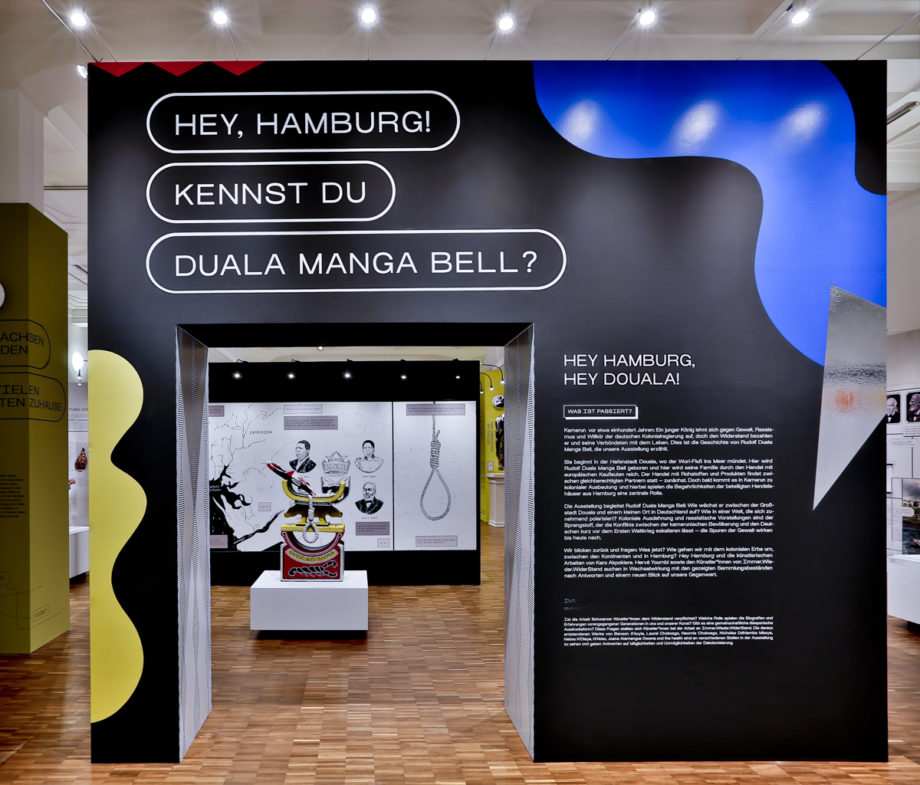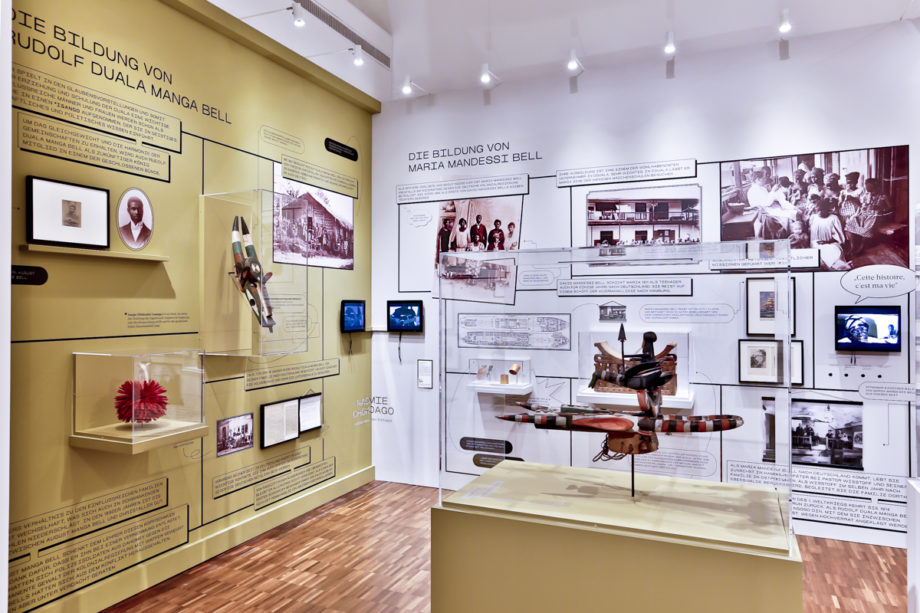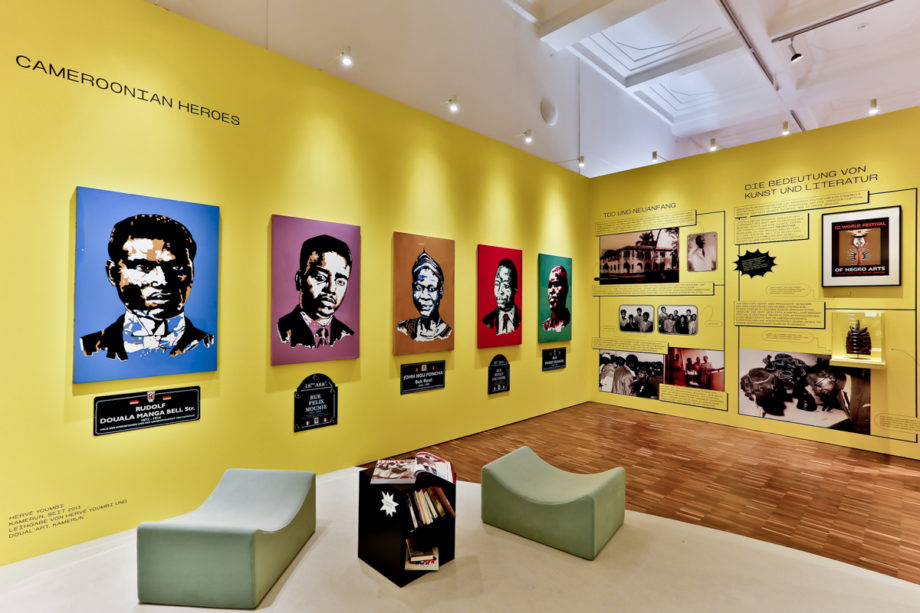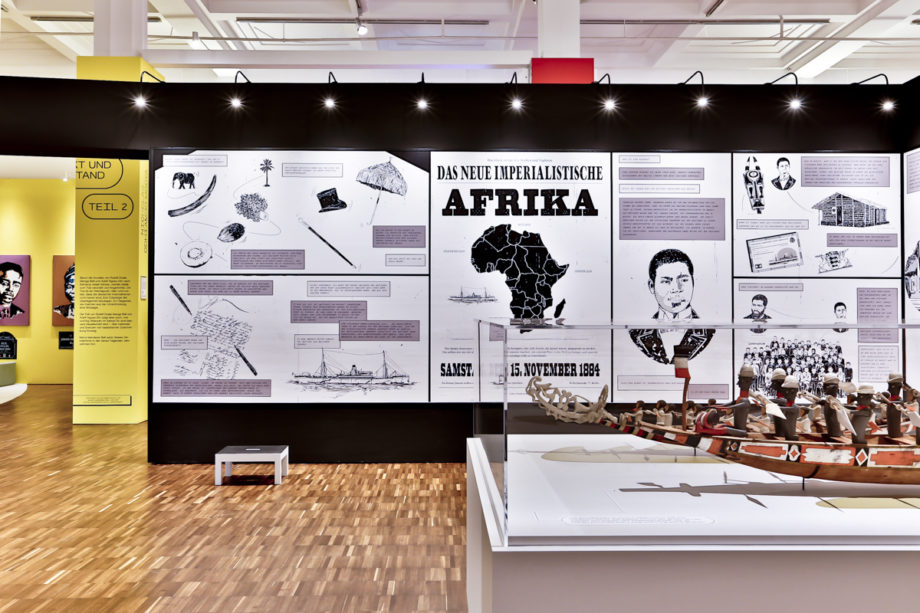An exhibition for the future, but what future for the exhibition?
Hey Hamburg, kennst du Rudolf Duala Manga Bell? at the MARKK
If you don’t live in Hamburg and already know the story of Rudolf Duala Manga Bell, you will naturally ask yourself whether a visit to the latest exhibition of the MARKK, entitled Hey Hamburg, do you know Rudolf Duala Manga Bell? would be worthwhile. The exhibition is part of the special programs MARKK in Motion and 360° from the German Federal Cultural Foundation, which supported the repositioning process at the museum during the last years. With its conversational title and gaudy aesthetics, the exhibition rather targets a young, local audience. It offers nonetheless a brilliant, albeit sometimes overloading, approach to colonial entanglements and ethnological collections to all ages and publics. Its diverse content and original story-telling approach paves the way for a promising future for museal approaches to the colonial past, memory cultures, and stories of conquest, migration and violence.

Fig. 1: central space in the first room of the exhibition with Hervé Youmbi’s artwork Tét’ékombo ô Mulema and Karo Akpokiere’s graphic novel on the black walls.
Before entering the southern wing of the Museum am Rothenbaum, the title will still call you out several times: on the promotional flyer, on the façade of the museum, on the sign directing visitors in the building and on the gate that stands at the entrance to the exhibition space. This way, the aim always remains clear: you will learn about Rudolf Duala Manga Bell’s life. But the structure of the exhibition is still a mystery. Only in the introductory text on the welcoming arch are visitors told that this exhibition was conceived as an “interaction” between the museum, its curatorial team and artists from Cameroon and Hamburg. Those multiple perspectives all occupied the space in their own way.
A novel in black and white with colourful corners
Although possibly disorienting, the composition of the room works quite well. The stories of Rudolf Duala Manga Bell, Maria Mandessi Bell and Adolf Ngoso Din are told in the centre of the room by means of a graphic novel. Drawn and written by artist Karo Akpokiere, the novel functions as a red thread, a “path”, and depicts a fictional dialogue between a (presumably Black) German and a Cameroonian (see Fig. 1 and 4). Akin to oral history, the graphic novel slithers on four walls in the middle of the room. The narrators relate colonial conquest and exploitation in Cameroon with segregation in apartheid South Africa. They also question to what extent coming to terms with the Nazi past has eclipsed or helped working through the colonial era. Thanks to seemingly naïve questions, the dialogue addresses complexities, breaks taboos, and unravels contradictions, such as the paradox “warum suchst du nach Gerechtigkeit bei Leuten, die sich deiner Unterdrückung verschrieben haben?”. (“Why do you seek justice from people who are dedicated to your oppression?”)
Akpokiere’s narrative seeks to answer the question he himself posed at the beginning of the exhibition catalogue: why did the Germans want Rudolf Duala Manga Bell dead? Not only does the fictional dialogue deftly addresses well-known historical “facts”, it also conveys how Rudolf Duala Manga Bell might have felt during his lifetime, a side of the story that has been relatively forgotten. Although violence is part of the narrative, it is never carelessly reproduced. Only the red of the Prussian imperial flag stands as a metonymy for blood.
Around that anchor, colourful painted areas give more detailed context to some aspects of the story and critical approaches to the involvement of the city of Hamburg in colonial conquest and occupation in Cameroon, from the first trading activities in 1880 to Manga Bell’s execution in 1914. Artistic interventions occupy interstitial spaces and engage with present-day positionalities, reflecting on the exhibition and towards the visitors. However, some of them appear out of tune and stand awkwardly in the space. Several topics are addresses in those peripheral spaces: Rudolf and Maria’s experiences when they lived in Germany, and the role of medicine in policies of colonial segregation, or Maria Mandessi Bell’s involvement in transnational literary networks in the mid-twentieth century. The selected artefacts (including magnificent tangués and paddles), archives, photographs and interviews contribute to a shift of perspective in colonial historiography by bringing the voices and experiences of the Duala elite to the fore. The curators have cleverly made different material “witnesses” of history speak. Material culture indeed takes part in the exhibition’s narrative, like King Akwa’s walking stick, framed as evidence of anti-colonial resistance. This staff stands as a symbol of his political interpretative authority and accompanies a timeline of all the petitions submitted by the Duala. Photographs of Douala’s elite and postcards and letters written by them also help deconstruct colonial racist ways of thinking, such as the dichotomy between “civilised” and “savage”, or the alleged separation between African oral tradition and European written accounts of history. Sarah Kala-Lobé, a member of the family, even provides a personal testimony which reminds that this history is not that old (see Fig. 2). Finally, archival documents clearly show that anti-colonial resistance at the time did not take place in form of an uprising or a war. For the Duala, it was rather a legal struggle towards political self-determination. This contextualisation provides important evidence on how German colonial rule used deceit and segregation to oppress local people, which then led to Manga Bell’s public advocacy for the grievances of the colonised.

Fig. 2: View of the corner dealing with Rudolf Duala and Maria Mandessi Bell’s education. On the right, Sarah Kala-Lobé gives a video interview on her knowledge as a member of the family entitled “This story is my life”.
By bringing together different voices from the present and the past, visitors get an impression of how complex the relationship between history and tradition is. At the same time, the exhibition confronts the paradigm of authenticity in museum culture by dissolving hierarchies and granting artefacts, archival material and artistic fiction plenipotentiary roles in the narrative. But if the artefacts are no longer the only central points of reference in the exhibition, the question remains: what does their presence say about the presence of collections from Douala in the MARKK?
A room of contrasts: static portraits, interaction and a mobile exhibition
Despite successful contrasts in hue, some aesthetics prevail in the exhibition. For instance, the genre of the portrait to depict colonised subjects and colonialists is omnipresent. These static, bourgeois faces rather convey the image of detached protagonists and often does not match the subject-matter, namely the recognition of human rights and the tough struggle for independence from colonialism. Besides, a lot of space is granted to portraits of white Europeans, whereas it could perhaps have been used for other kinds of representations. Only Hervé Youmbi’s artwork offers a different kind of portraits, Pop-art posters honouring anti-colonial Cameroonians and touching upon debates on decolonial renaming of streets (see Fig. 3).

Fig. 3: Hervé Youmbi’s installation Cameroonian Heroes in the space dedicated to independence and Maria Mandessi Bell’s literary work. Under the portraits of Manga Bell, John Ngu Foncha, Felix Moumié, Ruben Um Nyobé and Ernest Ouandie, street plaques of Berlin, Paris and London, honour those anticolonial leaders, all murdered because of their political commitment.
At the end of the “path”, a small corner functions as a transitional airlock between the past and the future, drawing from the literary and political engagement of Maria Mandessi Bell after the execution of her cousin to overlap smoothly towards questions on postcolonial German and Cameroonian societies that are addressed in the second room. There, visitors can sample beats and quotes on a looped “Soul Makossa”, watch interviews of people who participated in the exhibition’s conception, rest in front of the soothing video installation “The Vault” by Benson Akuyie, or learn about the Ngondo festival, a contemporary manifestation of the Sawa people’s cultural and political legacy. Unfortunately, all these stations seem to lack a common thread that would bring these different stations into contact. Again, numerous important topics are addressed, such as everyday racism in Germany or provenance research in the museum, and visitors might develop an interest to engage with those issues more deeply in the future. Nevertheless, the patchwork created reveals that it is challenging to embed many different voices, time periods and artworks in a collaborative curatorial work. This scenography emerging from these diverse dynamics reminds of a diverse, but also cramped, Instagram feed. This also somewhat holds true for the blending of some artistic interventions within the exhibition space. Yet, when talking about futures, this format might truly reflect best what awaits us…
The future that unfortunately remains unmentioned is the future of the exhibition. Indeed, as Rudolf’s descendant, Princess Marylin Douala Manga Bell, announces it in the catalogue, the exhibition will move to Cameroon. Yet, will it be a symmetrical diptych entitled Hey Douala, you know Rudolf Duala Manga Bell, right?, or a completely different one? What will remain, what will change, what will be added? A reflection on this challenging – yet relevant – format of a “repatriated”l[1] or mobile exhibition, and on the dialogue that it enables, might have helped building bridges between all those issues raised in the second room: provenance research and restitution, local vs. transnational memory, and relations between African and its diaspora. In any case, one thing remains unsaid: the museum’s position vis-à-vis possible future restitution claims after the return of the Tangués in Douala.

Fig. 4: View of Karo Akpokiere’s graphic novel. In the foreground, a tangué from the Duala.
Yann LeGall is postdoctoral researcher at the Institute for Art Studies at the TU Berlin and a member of the initiatives Berlin Postkolonial and Potscolonial Potsdam. As part of the DFG-AHRC research project “The Restitution of Knowledge“, he investigates the provenance of spoils of war and histories of colonial plunder during so-called “punitive expeditions”.
Malina Lauterbach is a research coordinator at TU Berlin as part of the Berlin University Alliance-funded project “Colonial Collections in Berlin Universities“. In 2020, she completed her Master’s degree in “Curating and Criticism” at the Staatliche Hochschule für Bildende Künste Städelschule and the Goethe University, Frankfurt am Main.
[1] The exhibition Mangi Meli Remains, curated by FlinnWorks, about the history of the then Mangi (king) of the Wachaga in Ukilima (Kilimanjaro region), which was shown at the Berlin Tieranatomisches Theater in 2018-2019, serves as an example of a “repatriated” exhibition about the German colonial period when it became a permanent exhibition in Old Moshi in March 2019, at the site where Meli and other Wachaga were executed by the German colonialists. Interestingly, in this case, a graphic novel-like video is also an integral part of an exhibition on German colonial violence on the African continent.































